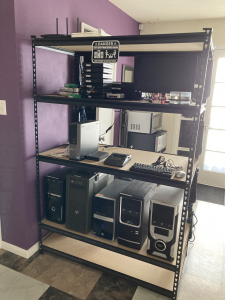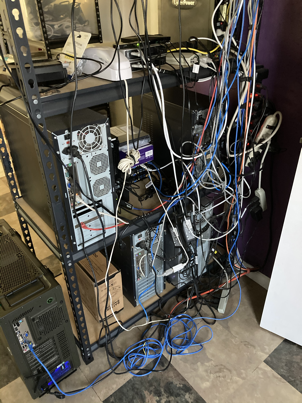UPDATE 24October2020: Added “after” picture at the end.
Any of you who tried to make an appointment this week (19-23 Oct 2020) might have heard that I’m out of the office and not able to take appointments, even telemedicine. He’s taking a vacation? The nerve! you might have thought. But, no, it’s not a vacation.
our IT infrastructure
You might know that for about 15 years before I went to medical school, I was a digital design engineer and telecommunications security consultant. What you might not know is that I run the entire information technology (IT) infrastructure for Sacramento Medical Oasis, Inc. — and there’s a lot of it. We handle multiple telephone lines, multiple fax lines, SMS (text messaging), email, telemedicine (our own Jitsi Meet system), electronic medical records (EMR), virtual private networking, domain name resolution (DNS), serving our web sites, electronic prescription verification, practice management, payment processing… the list goes on.
Why? First is money. If you go into a typical medical practice, IT infrastructure is usually one of their biggest expenses (though somewhat difficult to see, as it is divided among many different vendors). Running everything in-house, on repurposed out-of-date computers, keeps our costs low. Our datacenter runs primarily on solar power (with battery, grid, and then generator backup) on a stack of salvage servers.
The next driving factor is privacy. Benjamin Franklin once quipped that “three people can keep a secret if two of them are dead.” Yet many medical practices blithely share your personal medical information with their phone company, their EMR provider, their cloud services, their telemedicine provider, their web host, their email provider, their billing and practice management system, and on and on. Each of those, in turn, is likely to share your information with their IT infrastructure providers. At the end of the day, “privacy” legislation like HIPAA only promises that doctors will only share your information with people who promise to only share your information with other people who promise to only share your information with other people who promise… — you get the picture. By keeping your information completely within our own systems, we don’t have to rely on a long chain of pinky-swears to keep your data private.
repairs and maintenance
When we started this adventure—over ten years ago—I threw together much of the infrastructure over a long weekend. The idea was to get the basics in place, then refine during those long, slow months as the business was ramping up. Fortunately for our cash flow, but unfortunately for my recreational and family time, that slow ramp-up happened much faster than we had imagined possible. In true there is nothing so permanent as a temporary fix fashion, the work of updating and maintaining the IT infrastructure fell to my evenings and weekends, where it has remained for a decade. I think I’ve done well keeping up, but we’ve still accumulated technical debt. We now have over two dozen servers, a complex power management system that integrates the solar, 13 KWh battery, and grid power and lets us remotely dump lower-priority loads in the event of prolonged grid and solar outages. We have a two-level HVAC system for keeping all those servers cool even on backup power. I’ve had to add and remove multiple servers and switches and UPS units and fiber interfaces, often under intense time constraints (we don’t like the phones, faxes, or the EMR to be down even momentarily during business hours!). Try though I might to keep things neat, eventually the cabling gets our of control (see the photograph, above). We’ve generally been able to keep our software up to date, too, but there are one or two legacy systems that we have been unable to move to current systems because I haven’t had the time to do the reconfiguration.
time away
It eventually became clear that there simply wasn’t time to keep seeing patients and do the bulk work needed to pay off our technical debt. I tried to slow down the practice—I haven’t taken a new patient since August 2019—but then Covid–19 happened and the work of caring for my existing patients suddenly increased several fold. Nor has the crisis resolved in anything like the amount of time we all hoped for. Like single parents everywhere, I’m having to deal with “distance learning” while juggling a sharp increase in the acuity of patients’ anxiety and depression while keeping up on a daily flood of new information on the pandemic while coping with political unrest and racial injustice and limited opportunities for socializing and exercising and keeping my home sanitized and the air breathable as wildfires burn down the state. The only solution seemed to be to take a week away from direct patient care and take care of some of the deferred maintenance, though a week isn’t nearly enough to completely catch up.
how it affects you
I wish that, apart from making appointments harder to get this month, it wouldn’t have much effect on patient care. I don’t anticipate any visible problems during business hours, but there might be times after hours when an email is delayed or even bounces, or the phone system is temporarily down, or I’m not able to answer email or texts as quickly as usual (not that I’ve been able to keep up with that lately, either). Please be patient, and know that these infrastructure improvements will lead to A Brighter Future™.
—DrR
after…
There’s still a bit of work to do, but things are looking a lot better already…

